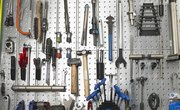
Digital calipers provide their users with accurate measurements of everything from hole size and depth, lengths, heights and more. However, as with all electronic tools, the calipers slowly begin to lose accuracy. Here is a way to calibrate your digital calipers.
Things You'll Need
- Digital Calipers
- Various shims of different thicknesses
- Gauge Blocks of a variety of thicknesses (optional)
Test and Calibrate your Calipers
After calibrating, affix a label to the calipers and write when they were calibrated and by whom. Depending on your usage, you should regularly calibrate your calipers.
Clean the calipers. Taking a lint-free cloth, much like those for use with eyeglasses, clean off all the dirt and oil from the head of the calipers and the body.
Close and zero the calipers. Bring the jaws as tightly closed as you can. Once there, zero the calipers.
Test repeatability. Open the calipers steadily as far as they can open, and close them again. Your display should read "Zero," or at most a single unit of the smallest amount (such as ".001" for those that can read that amount). If the amount is greater, then you may need to have the calipers recalibrated professionally. See Step 5.
Test against shims and, optionally, gauge blocks. Using just shims, find a few objects that measure from 1 inch to 2 inches to 3 inches, and so on. Measure the object's thickness, and then the thickness with a shim in place. The difference should match the shim's thickness. Gauge blocks are blocks that are precisely sized and can be used for this purpose, as well as testing the absolute measure of the blocks by themselves. If the measurements do not match up, you should have the calipers professionally calibrated.
If necessary, have a professional calibrate your calipers. Contact the manufacturer who may provide a calibration service for free or for a small fee. Manufacturers of precision tools, such as Starrett, SPI, Mitutoyo and so on, can also provide high precision services. Sometimes, it is best to leave things to a professional.
Tips
Tips
- After calibrating, affix a label to the calipers and write when they were calibrated and by whom. Depending on your usage, you should regularly calibrate your calipers.
About the Author
James McIlhargey is currently attending the University of Texas as a doctoral candidate in physics. In addition to his studies, McIlhargey has quite a bit of experience in electronics, engineering and other science-related fields, which he uses to write online content for various websites.
